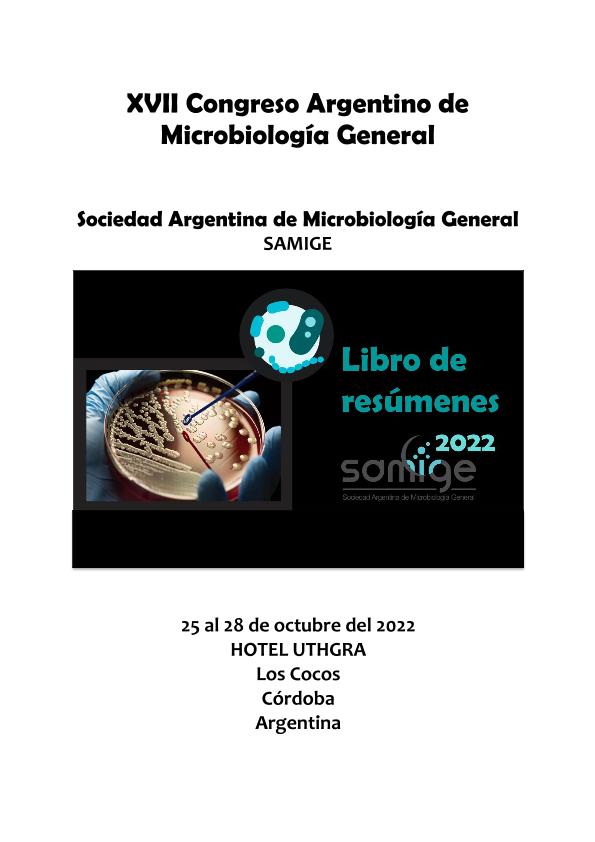Mostrar el registro sencillo del ítem
dc.contributor.author
Andrada Suarez, Eduardo Ezequiel

dc.contributor.author
Sandoval, Evangelina

dc.contributor.author
Fernández Baldo, Martín Alejandro

dc.contributor.author
Cuozzo, Sergio Antonio

dc.date.available
2023-09-01T15:14:22Z
dc.date.issued
2022
dc.identifier.citation
Cloning and expression in E. coli of the linA gene from Streptomyces sp. M7, encoding a dechlorinase enzyme; XVII Congreso Argentino de Microbiología General; Los Cocos; Argentina; 2022; 73-74
dc.identifier.uri
http://hdl.handle.net/11336/210170
dc.description.abstract
Streptomyces sp. M7 is an actinobacterium isolated from contaminated sediments with heavy metals and pesticides in Northern Argentina and is able to grow in the presence of hexachlorocyclohexane isomers (γ-HCH, α-HCH, β-HCH) as carbon sources. This property is due to the presence of a high and low metabolic pathway for xenobiotics degradation, where the first enzyme corresponds to LinA, dehydrochlorinase/dehydrohalogenase. This is able to catalyze the breaking of the highly resistant C-Cl bonds of hexachlorocyclohexane, an essential step for its subsequent biodegradation into less toxic metabolic intermediates and/or final products such as carbon dioxide and water. In this work, the linA gene belonging to Streptomyces sp. M7 that codes for dehydrochlorinase (DHC) was synthesized (GenBank: MH703800). The sequence was adapted according to high-frequency-usage codons in E. coli. In the sequence redesign process, two restriction sites, NcoI and XhoI, were added, which are in the bacterial vector pET28a+ used for the expression of 6xHis-tagged N-terminal proteins with a thrombin site. Previously, the synthetic DNA sequence was constructed and cloned in a pTOP Blunt V2 plasmid that was later treated with both restriction enzymes, giving rise to an expected fragment of 475 bp. The released fragment was cloned into the pET28a+ vector and was transformed in competent E. coli BL21 (DE3) host cells with T7 phage promoter. In the same way, transformants were obtained with the expression vector without the cloning fragment and used as control. It should be noted that the plasmid sequence construction and analysis were performed using the Vector NTI software. Subsequently, for the differential expression assay optimization, different conditions were analyzed: 0.4 mM, 0.7 mM, and 1 mM of IPTG, temperatures of 30 and 37 °C and variable times. The most favorable setups were 1 mM of IPTG, 37 °C, and 2 hours of incubation. Subsequently, the cell-free extract was obtained by sonication and analyzed by SDS-PAGE. The stained gels showed a differential band of approximately 39,000 Daltons, confirming the expression of the LinA-6xHis fusion protein. This approach will allow the analysis of the LinA enzyme, as well as its subsequent application in bioremediation technologies.
dc.format
application/pdf
dc.language.iso
eng
dc.publisher
Sociedad Argentina de Microbiología General
dc.rights
info:eu-repo/semantics/openAccess
dc.rights.uri
https://creativecommons.org/licenses/by-nc-sa/2.5/ar/
dc.subject
DECHLORINASE
dc.subject
EXPRESSION
dc.subject
BIOREMEDIATION
dc.subject
LINDANE
dc.subject.classification
Biotecnología Medioambiental

dc.subject.classification
Biotecnología del Medio Ambiente

dc.subject.classification
INGENIERÍAS Y TECNOLOGÍAS

dc.title
Cloning and expression in E. coli of the linA gene from Streptomyces sp. M7, encoding a dechlorinase enzyme
dc.type
info:eu-repo/semantics/publishedVersion
dc.type
info:eu-repo/semantics/conferenceObject
dc.type
info:ar-repo/semantics/documento de conferencia
dc.date.updated
2023-08-14T11:04:04Z
dc.journal.pagination
73-74
dc.journal.pais
Argentina

dc.description.fil
Fil: Andrada Suarez, Eduardo Ezequiel. Consejo Nacional de Investigaciones Científicas y Técnicas. Centro Científico Tecnológico Conicet - Tucumán. Planta Piloto de Procesos Industriales Microbiológicos; Argentina
dc.description.fil
Fil: Sandoval, Evangelina. Consejo Nacional de Investigaciones Científicas y Técnicas. Centro Científico Tecnológico Conicet - Tucumán. Planta Piloto de Procesos Industriales Microbiológicos; Argentina
dc.description.fil
Fil: Fernández Baldo, Martín Alejandro. Consejo Nacional de Investigaciones Científicas y Técnicas. Centro Científico Tecnológico Conicet - San Luis. Instituto de Química de San Luis. Universidad Nacional de San Luis. Facultad de Química, Bioquímica y Farmacia. Instituto de Química de San Luis; Argentina
dc.description.fil
Fil: Cuozzo, Sergio Antonio. Consejo Nacional de Investigaciones Científicas y Técnicas. Centro Científico Tecnológico Conicet - Tucumán. Planta Piloto de Procesos Industriales Microbiológicos; Argentina. Universidad Nacional de Tucumán. Facultad de Ciencias Naturales e Instituto Miguel Lillo; Argentina
dc.relation.alternativeid
info:eu-repo/semantics/altIdentifier/url/https://samige.org.ar/wp-content/uploads/2022/10/Libro-de-Resumenes-SAMIGE-2022_final.pdf
dc.conicet.rol
Autor

dc.conicet.rol
Autor

dc.conicet.rol
Autor

dc.conicet.rol
Autor

dc.coverage
Nacional
dc.type.subtype
Congreso
dc.description.nombreEvento
XVII Congreso Argentino de Microbiología General
dc.date.evento
2022-10-25
dc.description.ciudadEvento
Los Cocos
dc.description.paisEvento
Argentina

dc.type.publicacion
Book
dc.description.institucionOrganizadora
Sociedad Argentina de Microbiología General
dc.source.libro
Libro de resúmenes del XVII Congreso Argentino de Microbiología General
dc.date.eventoHasta
2022-10-28
dc.type
Congreso
Archivos asociados
